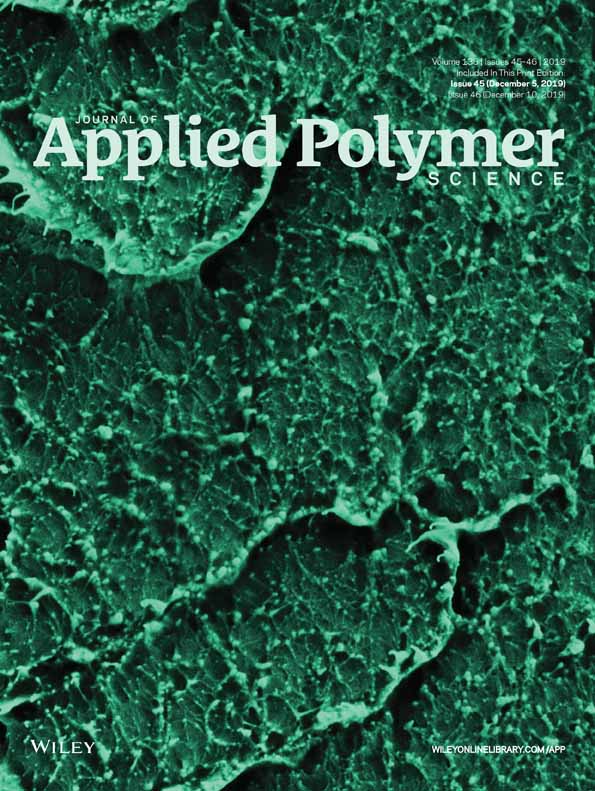RhCl(TPPTS)3 supported on iota-carrageenan as recyclable catalysts for Suzuki cross-coupling
Sivan Leviev
Department of Chemical Engineering, Sami Shamoon College of Engineering, Basel/Bialik Sts, Beer-Sheva, 8410001 Israel
Search for more papers by this authorAdi Wolfson
Department of Chemical Engineering, Sami Shamoon College of Engineering, Basel/Bialik Sts, Beer-Sheva, 8410001 Israel
Search for more papers by this authorCorresponding Author
Oshrat Levy-Ontman
Department of Chemical Engineering, Sami Shamoon College of Engineering, Basel/Bialik Sts, Beer-Sheva, 8410001 Israel
Correspondence to: O. Levy-Ontman (E-mail: [email protected])Search for more papers by this authorSivan Leviev
Department of Chemical Engineering, Sami Shamoon College of Engineering, Basel/Bialik Sts, Beer-Sheva, 8410001 Israel
Search for more papers by this authorAdi Wolfson
Department of Chemical Engineering, Sami Shamoon College of Engineering, Basel/Bialik Sts, Beer-Sheva, 8410001 Israel
Search for more papers by this authorCorresponding Author
Oshrat Levy-Ontman
Department of Chemical Engineering, Sami Shamoon College of Engineering, Basel/Bialik Sts, Beer-Sheva, 8410001 Israel
Correspondence to: O. Levy-Ontman (E-mail: [email protected])Search for more papers by this authorABSTRACT
A rhodium complex was immobilized for the first time in iota-carrageenan polysaccharide to render a xerogel catalyst. This new heterogeneous catalyst was successfully used in Suzuki cross-coupling and was easily separated from the reaction mixture and recycled two times without loss of activity. The rhodium heterogeneous catalyst was characterized by FTIR, SEM-EDS, and TEM analyses, which demonstrated that the catalyst complex successfully embedded within the polysaccharide and exhibited an unordered, porous structure. Moreover, it was demonstrated that the novel and simple heterogenization procedure, which has been used previously for palladium complexes, is a general route to immobilize transition metal complexes in polysaccharide matrixes. © 2019 Wiley Periodicals, Inc. J. Appl. Polym. Sci. 2019, 136, 48200.
REFERENCES
- 1Miyaura, N.; Kinji, Y.; Suzuki, A. Tetrahedron Lett. 1979, 20, 3437.
- 2Miyaura, N.; Suzuki, A. Chem. Rev. 1995, 95, 2457.
- 3Bellina, F.; Carpita, A.; Rossi, R. Synthesis. 2004, 15, 2419.
- 4Corbet, J. P.; Mignani, G. Chem. Rev. 2006, 106, 2651.
- 5Fenger, I.; Le Drian, C. Tetrahedron Lett. 1998, 39, 4287.
- 6Li, Y.; Hong, X. M.; Collard, D. M.; El-Sayed, M. A. Org. Lett. 2000, 2, 2385.
- 7Mathews, C. J.; Smith, P. J.; Welton, T. Chem. Commun. 2000, 14, 1249.
- 8Wolfson, A.; Dlugy, C. Chem. Pap. 2007, 61, 228.
- 9Maluenda, I.; Navarro, O. Molecules. 2015, 20, 7528.
- 10Chatterjee, A.; Ward, T. R. Catal. Lett. 2016, 146, 820.
- 11Percec, V.; Bae, J. Y.; Hill, D. H. J. Org. Chem. 1995, 60, 1060.
- 12Baghbanzadeh, M.; Pilger, C.; Kappe, C. O. J. Org. Chem. 2011, 76, 1507.
- 13Zultanski, S. L.; Fu, G. C. J. Am. Chem. Soc. 2013, 135, 624.
- 14Dong, L.; Wen, J.; Qin, S.; Yang, N.; Yang, H.; SU, Z.; Yu, X.; Hu, C. ACS Catal. 2012, 2, 1829.
- 15Hatakeyama, T.; Hashimoto, T.; Kathriarachchi, K. K. A. D. S.; Zenmyo, T.; Seike, H.; Nakamura, M. Angew. Chem. Int. Ed. 2012, 51, 8834.
- 16Thathagar, M. B.; Beckers, J.; Rothenberg, G. J. Am. Chem. Soc. 2002, 124, 11858.
- 17Fuerstner, A.; Krause, H. Adv. Synth. Catal. 2001, 343, 343.
- 18Ueura, K.; Satoh, T.; Miura, M. Org. Lett. 2005, 7, 2229.
- 19Moreau, C.; Hague, C.; Weller, A. S.; Frost, C. G. Tetrahedron Lett. 2001, 42, 6957.
- 20Yin, L.; Liebscher, J. Chem. Rev. 2007, 107, 133.
- 21Pérez-Lorenzo, M. J. Phys. Chem Lett. 2012, 3, 167.
- 22Jin, M. J.; Lee, D. H. Angew. Chem. 2010, 122, 1137.
- 23Mpungose, P.; Vundla, Z.; Maguire, G.; Friedrich, H. Molecules. 2018, 23, 1676.
- 24Guha, N. R.; Reddy, C. B.; Aggarwal, N.; Sharma, D.; Shil, A. K.; Das, P. Adv. Synth. Catal. 2012, 354, 2911.
- 25Gniewek, A.; Trzeciak, A. M. Top. Catal. 2013, 56, 1239.
- 26Yasukawa, T.; Miyamura, H.; Kobayashi, S. Chem. Sci. 2015, 6, 6224.
- 27Primo, A.; Liebel, M.; Quignard, F. Chem. Mater. 2009, 21, 621.
- 28Chen, W.; Zhong, L.; Peng, X.; Lin, J.; Sun, R. Cellulose. 2014, 21, 125.
- 29Makhubela, B. C.; Jardine, E. A.; Smith, G. S. Appl. Catal. A-Gen. 2011, 393, 231.
- 30Cotugno, P.; Casiello, M.; Nacci, A.; Mastrorilli, P.; Dell'Anna, M. M.; Monopoli, A. J. Organomet. Chem. 2014, 752, 1.
- 31Yi, S. S.; Lee, D. H.; Sin, E.; Lee, Y. S. Tetrahedron Lett. 2007, 48, 6771.
- 32Baran, T.; Sargin, I.; Kaya, M.; Menteş, A. J. Mol. Catal. A: Chem. 2016, 420, 216.
- 33Baran, T.; Baran, N. Y.; Menteş, A. Appl. Organo. Chem. 2018, 32, e4076.
- 34Levy-Ontman, O.; Biton, S.; Shlomov, B.; Wolfson, A. Polymers. 2018, 10, 659.
- 35Wolfson, A.; Biton, S.; Levy-Ontman, O. RSC Adv. 2018, 8, 37939.
- 36Necas, J.; Bartosikova, L. Vet. Med. 2013, 58, 187.
- 37Gilbert, L.; Mercier, C. Solvent effects in heterogeneous catalysis: Application to the synthesis of fine chemicals. In Heterogeneous Catalysis and Fine Chemicals III; J. Barbier; J. Barrault; C. Bouchoule; D. Duprez; C. Montassier; M. Guisnet; P. Pérot, Eds.; Elsevier: Amsterdam, 1993; p. 51.
10.1016/S0167-2991(08)63303-0 Google Scholar
- 38Gómez-Ordóñez, E.; Rupérez, P. Food Hydrocoll. 2011, 25, 1514.
- 39Pereira, L.; Amado, A. M.; Critchly, A. T.; van de Velde, F.; Ribeiro-Claro, P. J. A. Food Hydrocoll. 2009, 23, 1903.
- 40Sankalia, M. G.; Mashru, R. C.; Sankalia, J. M.; Sutariya, V. B. J. Pharm. Sci. 2006, 95, 1994.
- 41Volery, P.; Besson, R.; Schaffer-Lequart, C. J. Agric. Food Chem. 2004, 52, 7457.




